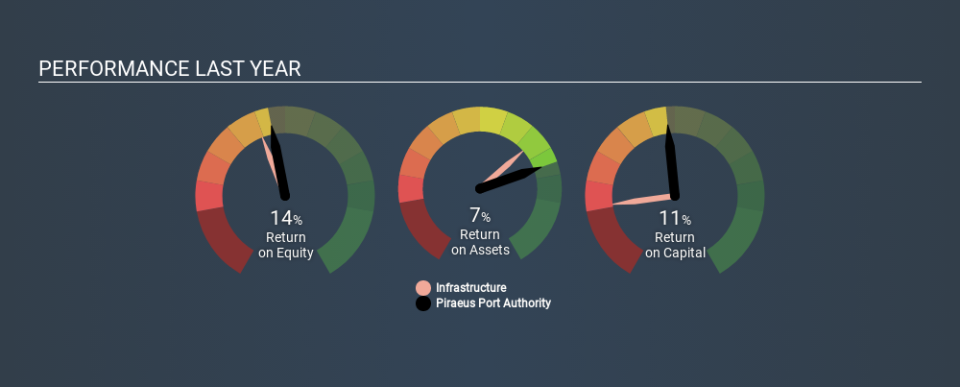Are Piraeus Port Authority S.A.’s (ATH:PPA) High Returns Really That Great?

Today we are going to look at Piraeus Port Authority S.A. (ATH:PPA) to see whether it might be an attractive investment prospect. In particular, we'll consider its Return On Capital Employed (ROCE), as that can give us insight into how profitably the company is able to employ capital in its business.
First up, we'll look at what ROCE is and how we calculate it. Next, we'll compare it to others in its industry. And finally, we'll look at how its current liabilities are impacting its ROCE.
Return On Capital Employed (ROCE): What is it?
ROCE is a metric for evaluating how much pre-tax income (in percentage terms) a company earns on the capital invested in its business. Generally speaking a higher ROCE is better. Overall, it is a valuable metric that has its flaws. Author Edwin Whiting says to be careful when comparing the ROCE of different businesses, since 'No two businesses are exactly alike.
So, How Do We Calculate ROCE?
Analysts use this formula to calculate return on capital employed:
Return on Capital Employed = Earnings Before Interest and Tax (EBIT) ÷ (Total Assets - Current Liabilities)
Or for Piraeus Port Authority:
0.11 = €47m ÷ (€467m - €53m) (Based on the trailing twelve months to June 2019.)
So, Piraeus Port Authority has an ROCE of 11%.
Check out our latest analysis for Piraeus Port Authority
Does Piraeus Port Authority Have A Good ROCE?
ROCE is commonly used for comparing the performance of similar businesses. Piraeus Port Authority's ROCE appears to be substantially greater than the 8.9% average in the Infrastructure industry. I think that's good to see, since it implies the company is better than other companies at making the most of its capital. Regardless of where Piraeus Port Authority sits next to its industry, its ROCE in absolute terms appears satisfactory, and this company could be worth a closer look.
In our analysis, Piraeus Port Authority's ROCE appears to be 11%, compared to 3 years ago, when its ROCE was 0.3%. This makes us think about whether the company has been reinvesting shrewdly. You can see in the image below how Piraeus Port Authority's ROCE compares to its industry. Click to see more on past growth.
It is important to remember that ROCE shows past performance, and is not necessarily predictive. ROCE can be deceptive for cyclical businesses, as returns can look incredible in boom times, and terribly low in downturns. ROCE is only a point-in-time measure. Since the future is so important for investors, you should check out our free report on analyst forecasts for Piraeus Port Authority.
How Piraeus Port Authority's Current Liabilities Impact Its ROCE
Liabilities, such as supplier bills and bank overdrafts, are referred to as current liabilities if they need to be paid within 12 months. The ROCE equation subtracts current liabilities from capital employed, so a company with a lot of current liabilities appears to have less capital employed, and a higher ROCE than otherwise. To counter this, investors can check if a company has high current liabilities relative to total assets.
Piraeus Port Authority has total liabilities of €53m and total assets of €467m. Therefore its current liabilities are equivalent to approximately 11% of its total assets. Current liabilities are minimal, limiting the impact on ROCE.
What We Can Learn From Piraeus Port Authority's ROCE
This is good to see, and with a sound ROCE, Piraeus Port Authority could be worth a closer look. Piraeus Port Authority looks strong on this analysis, but there are plenty of other companies that could be a good opportunity . Here is a free list of companies growing earnings rapidly.
I will like Piraeus Port Authority better if I see some big insider buys. While we wait, check out this free list of growing companies with considerable, recent, insider buying.
If you spot an error that warrants correction, please contact the editor at editorial-team@simplywallst.com. This article by Simply Wall St is general in nature. It does not constitute a recommendation to buy or sell any stock, and does not take account of your objectives, or your financial situation. Simply Wall St has no position in the stocks mentioned.
We aim to bring you long-term focused research analysis driven by fundamental data. Note that our analysis may not factor in the latest price-sensitive company announcements or qualitative material. Thank you for reading.

